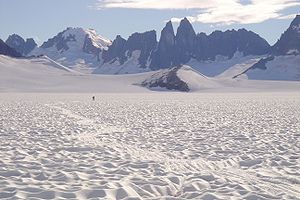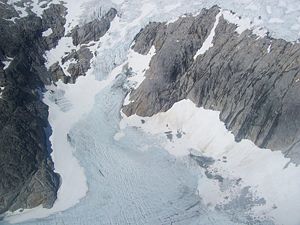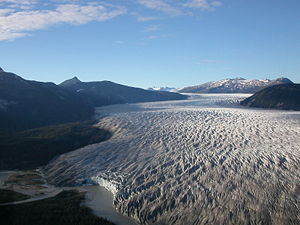
Taku Glacier
Encyclopedia
Taku Glacier is a tidewater glacier located in Taku Inlet in the U.S. state
of Alaska
, just southeast of the city of Juneau
. Recognized as the deepest and thickest glacier known in the world, the Taku Glacier is measured at 4845 feet (1,476.8 m).
The glacier was originally named Schultze Glacier in 1883 and the Foster Glacier in 1890, but Taku, the name the local Tlingit natives had for the glacier, eventually stuck. It is nestled in the Coast Mountains
and originates in the Juneau Icefield
. It is the largest glacier in the icefield and one of the southernmost tidewater glaciers of the northern hemisphere.
The glacier, which converges with the Taku River
at Taku Inlet, has a history of advancing until it blocks the river, creating a lake, followed by a dramatic break of the ice dam
. The most recent of these advances occurred in 1750. The glacier has advanced 7.5 kilometres (4.7 mi) since 1890, and is 1.5 kilometre (0.93205910497471 mi) from Taku Point. It is the only advancing glacier of the 20 major glaciers of the Juneau Icefield. If the advance continues it will again block the river, but this appears unlikely at present. Since 1946, the glacier has been monitored by the Juneau Icefield Research Program, which has documented its rate of advance since 1988 at 17 metres (55.8 ft) a year. The advance is due to a positive mass balance
; that is, more snow accumulates than snow and ice melt. Until 1948 the glacier had a calving
front; since then the terminus
has been grounded.
Due to the positive mass balance and the fact that it was no longer losing mass to iceberg
s, Taku Glacier has become insensitive to the warming that has impacted all other glaciers of the icefield. This has driven its advance. The recent negative mass balance 1989-2005 is not large enough yet to stop the advance, but it is the first sign that the glacier's advance may not take it to Taku Point.

 Taku Glacier is the namesake of the Alaska Marine Highway System ferry M/V Taku
Taku Glacier is the namesake of the Alaska Marine Highway System ferry M/V Taku
.
U.S. state
A U.S. state is any one of the 50 federated states of the United States of America that share sovereignty with the federal government. Because of this shared sovereignty, an American is a citizen both of the federal entity and of his or her state of domicile. Four states use the official title of...
of Alaska
Alaska
Alaska is the largest state in the United States by area. It is situated in the northwest extremity of the North American continent, with Canada to the east, the Arctic Ocean to the north, and the Pacific Ocean to the west and south, with Russia further west across the Bering Strait...
, just southeast of the city of Juneau
Juneau, Alaska
The City and Borough of Juneau is a unified municipality located on the Gastineau Channel in the panhandle of the U.S. state of Alaska. It has been the capital of Alaska since 1906, when the government of the then-District of Alaska was moved from Sitka as dictated by the U.S. Congress in 1900...
. Recognized as the deepest and thickest glacier known in the world, the Taku Glacier is measured at 4845 feet (1,476.8 m).
The glacier was originally named Schultze Glacier in 1883 and the Foster Glacier in 1890, but Taku, the name the local Tlingit natives had for the glacier, eventually stuck. It is nestled in the Coast Mountains
Coast Mountains
The Coast Mountains are a major mountain range, in the Pacific Coast Ranges, of western North America, extending from southwestern Yukon through the Alaska Panhandle and virtually all of the Coast of British Columbia. They are so-named because of their proximity to the sea coast, and are often...
and originates in the Juneau Icefield
Juneau Icefield
The Juneau Icefield is an ice field located just north of Juneau, Alaska and continues north through the border with British Columbia and is the fifth-largest ice field in the Western Hemisphere, extending through an area of in the Coast Range ranging north to south and east to west. The...
. It is the largest glacier in the icefield and one of the southernmost tidewater glaciers of the northern hemisphere.
The glacier, which converges with the Taku River
Taku River
The Taku River is a river running from British Columbia, Canada, to the northwestern coast of North America, at Juneau, Alaska. Its mouth coincides with the Alaska-British Columbia border...
at Taku Inlet, has a history of advancing until it blocks the river, creating a lake, followed by a dramatic break of the ice dam
Ice dam
An ice dam occurs when water builds up behind a blockage of ice. Ice dams can occur in various ways.-Caused by a glacier:Sometimes a glacier flows down a valley to a confluence where the other branch carries an unfrozen river...
. The most recent of these advances occurred in 1750. The glacier has advanced 7.5 kilometres (4.7 mi) since 1890, and is 1.5 kilometre (0.93205910497471 mi) from Taku Point. It is the only advancing glacier of the 20 major glaciers of the Juneau Icefield. If the advance continues it will again block the river, but this appears unlikely at present. Since 1946, the glacier has been monitored by the Juneau Icefield Research Program, which has documented its rate of advance since 1988 at 17 metres (55.8 ft) a year. The advance is due to a positive mass balance
Glacier mass balance
Crucial to the survival of a glacier is its mass balance, the difference between accumulation and ablation . Climate change may cause variations in both temperature and snowfall, causing changes in mass balance. Changes in mass balance control a glacier's long term behavior and is the most...
; that is, more snow accumulates than snow and ice melt. Until 1948 the glacier had a calving
Ice calving
Ice calving, also known as glacier calving or iceberg calving, is a form of ice ablation or ice disruption. It is the sudden release and breaking away of a mass of ice from a glacier, iceberg, ice front, ice shelf, or crevasse...
front; since then the terminus
Glacier terminus
A glacier terminus, or snout, is the end of a glacier at any given point in time. Although glaciers seem motionless to the observer, in reality glaciers are in endless motion and the glacier terminus is always either advancing or retreating...
has been grounded.
Due to the positive mass balance and the fact that it was no longer losing mass to iceberg
Iceberg
An iceberg is a large piece of ice from freshwater that has broken off from a snow-formed glacier or ice shelf and is floating in open water. It may subsequently become frozen into pack ice...
s, Taku Glacier has become insensitive to the warming that has impacted all other glaciers of the icefield. This has driven its advance. The recent negative mass balance 1989-2005 is not large enough yet to stop the advance, but it is the first sign that the glacier's advance may not take it to Taku Point.



M/V Taku
M/V Taku is a Malaspina-class mainline vessel for the Alaska Marine Highway System.Designed by Phillip F. Spaulding & Associates, constructed in 1963 by the Puget Sound Bridge & Dry Dock Company in Seattle, Washington, the M/V Taku is named after Taku Glacier which is located just southeast of...
.

